South Coast Orchid Society
AOS Judging Center

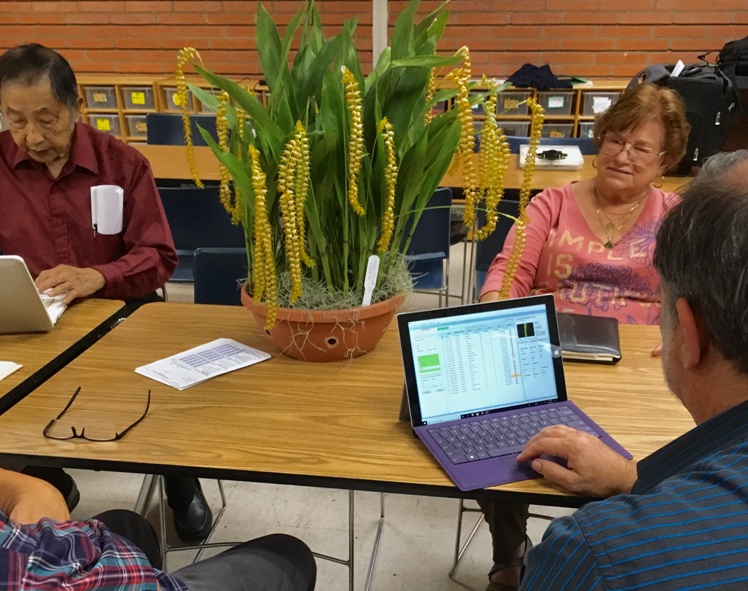
AOS judges at work at Long Beach center. Did this Dendrochilum win an award? We're still not sure.
SCOS for many years provided space for an official American Orchid Society (AOS) judging center during our monthly meetings. This beneficial arrangement ended in December, 2022, when the AOS judging center pulled up stakes and moved to Yorba Linda. The Long Beach site, known as the Pacific South Supplemental Judging Center, was in turn a part of the Pacific South Judging Center. Visitors to the judging center were welcomed and encouraged! Information and photographs from Pacific South Judging awards are on a separate web site (however, the two web sites referenced here are currently out of sync and will need further updating).
In fact, judging at SCOS goes back even farther. Late in 1954, when SCOS was still very young, we were an affiliate society of Orchid Digest Corporation (ODC), which was developing its own judging program. By a vote of our membership at our October, 1954 meeting, we decided to begin judging as a regular feature of our meetings, to begin in December, 1954, at first relying on judges already certified by ODC, until our own members could be certified as judges. Judging thus began at SCOS meetings in December, 1954, and continued uninterrupted under ODC standards until the end of 1967. At that point, the ODC and AOS judging programs were merged (under AOS standards; all of the ODC judges were automatically recertified as AOS judges), and AOS judging began at SCOS meetings in January, 1968. It continued until December, 2022, although for a brief period, roughly April, 2000 to September, 2001, the judging center met separately, at Costa Mesa or at the Huntington Botanical Center, before returning to our meetings at Whaley Park in October, 2001. During the Covid-19 pandemic (March, 2020 to March, 2022), too, while SCOS was unable to meet and the Whaley Park facility was not available, the judging team met a few times at other locations.
Our very long history of supporting local judging is, as we understand it, unusual and possibly unique. We hope our friends from the judging community will visit our meetings whenever their schedules permit! We have learned much from our long association with them. We have had the benefit of their knowledge and experience in all matters orchid, and we have had the opportunity to see some remarkable plants that were brought in for evaluation.
We have a partial list of the Long Beach ODC awards from our newsletters and from reports published in Orchid Digest. We also have compiled the surviving Long Beach ODC award photos.
The list of AOS awards from the Long Beach site in the current AOS awards database ("OrchidPro", accessible to members on the AOS web site) was initially believed to be largely complete, but many of the early awards are listed in the database without pictures and sometimes without complete information, a lapse that we are working to correct, and our research revealed a number of errors and omissions.
We have reviewed the early AOS awards 1968-1980 that were published in our newsletters, comparing them with reports of awards in the AOS Bulletin, OrchidPro, the proprietary database OrchidWiz, and other sources. The results of that review are now published on this site as a series of Long Beach AOS award web pages, currently showing award information and photos for 1968-1980. We are grateful for the assistance of Laura Newton, AOS Awards Coordinator; Julian Shaw, RHS Registrar of Orchids; and Susan Eubank, librarian at the Los Angeles County and State Arboretum in tracking down sources and, in some, cases, correcting records. As a result of our review, it is now clear that many award records need to be corrected, a long-term project that is still taking shape.
The AOS established its first systematic program of judging orchids in 1949. Judges are trained to apply a uniform set of standards across all judging centers. The AOS judging program serves several purposes:
- Provides recognition for superior cultivars
- Provides recognition for outstanding growers
- Provides an extensive educational resource for all orchid growers, professional and amateur alike, in matters of selecting desirable plants, growing them for best effect, and identifying them correctly.
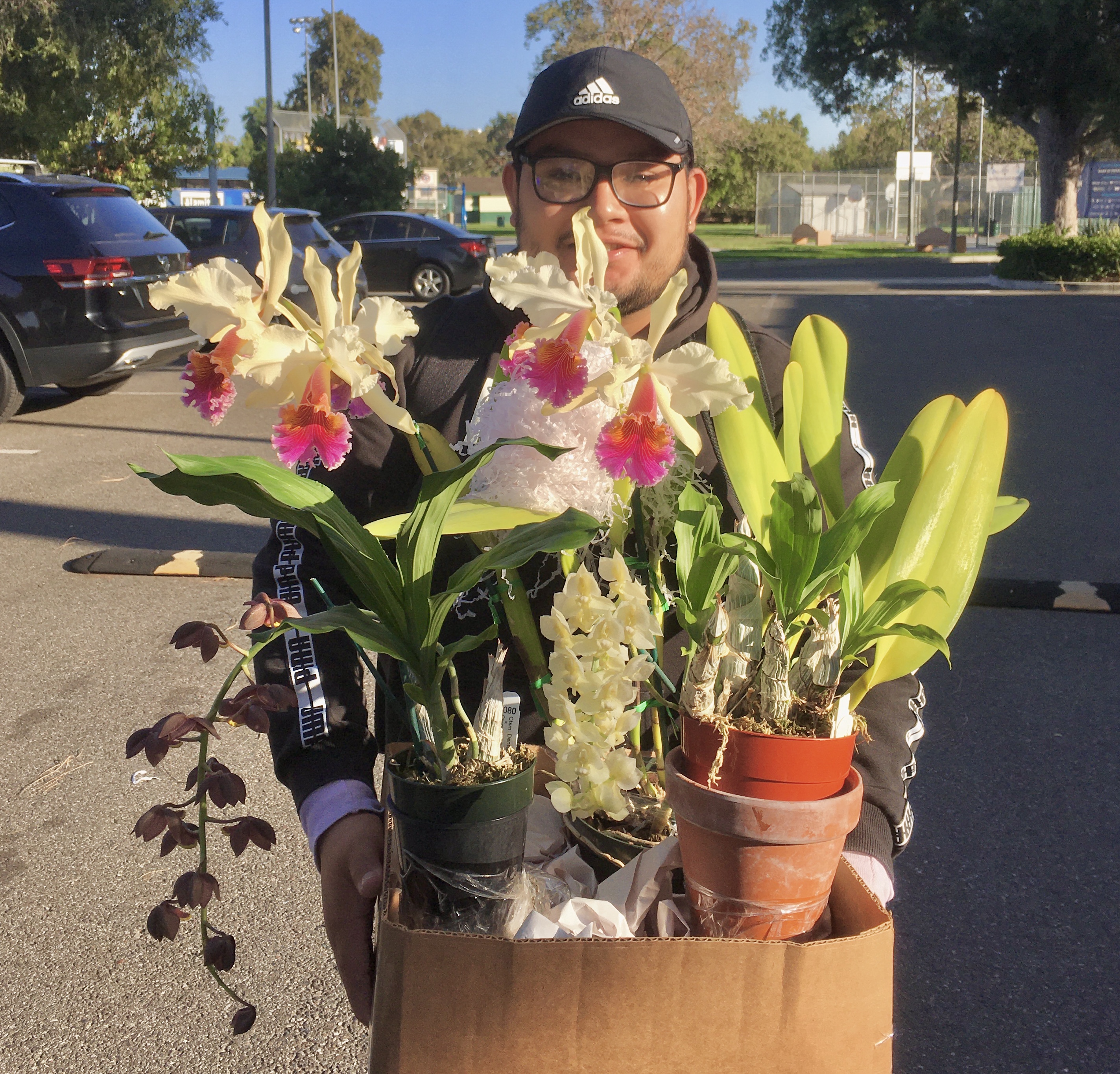
Carlos Lopez arrived at our June 27, 2022 meeting with armloads of gorgeous plants for judging. The big one here is Cattleya Triumphans (C. dowiana × rex).
On the other hand, beauty is in the eye of the beholder. There is nothing wrong with preferring a particular plant that never won any awards, but nevertheless pleases YOU! Fashions in orchid flowers change over time. The judging system may not catch on to new trends immediately.
Southern California orchid hobbyists were deeply involved in the development of judging standards for Orchid Digest Corporation and American Orchid Society in the 1940's and leading up to the consolidation of ODC and AOS judging in 1968. Members of the Southern California ODC chapter that became the Orchid Society of Southern California were especially active, and the same people soon were involved in SCOS activities as well, including the new judging team formed in December, 1954. A thorough history of these developments has yet to be written, but we can find scattered reports in the early newsletters, Orchid Digest, and other Southern California sources.
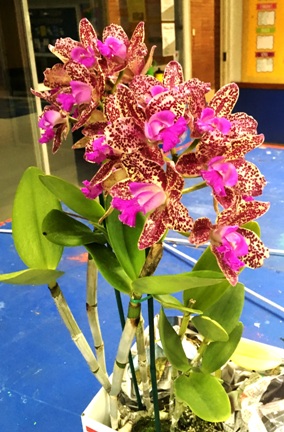
Wow, I see spots! Look what turned up at the judging center!
However, awarded plants are often the ones that are selected for cloning and mass marketing. Awarded plants are more likely to be used in breeding new hybrids as well. Over time, the judging program influences the direction of orchid breeding, growing, and marketing.
One reason to be aware of the judging system is that you could easily end up with a first-bloom seedling that happens to turn out exceptionally well. Remember that seedling orchids from a given cross usually show many differences in form, color, growth habit, etc. Most seedlings of hybrid orchids are sold to the public before they have bloomed. Someone has to get the best plant from among the unbloomed seedlings of a particular cross, and that someone could well be you! Bringing your plant to one of our meetings for judging is the way to find out if you have something special!
Most of the plants that win an AOS award at the Long Beach judging center will appear in the SCOS newsletter, an excellent resource for keeping track of who's growing what in our area.
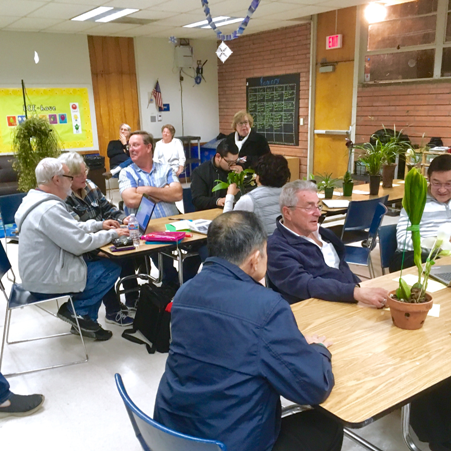
Busy night at the judging center.
You never know how many plants will show up for judging. At one meeting, January 28, 2019, while Peter Lin was busy presenting a program
for SCOS in the main hall, the judging team in the back room found itself faced with 31 submitted plants, of which something like 22 were accepted for judging. Visiting judges were pressed into service, but the process takes time. Modern judging tries to document everything. Even if the Dendrobium teretifolium
(it's lurking in the background in a couple of these pictures, cascading from a basket on a plant stand, nearly reaching the floor) happens to have
several hundred little flowers, somebody has to count them! All the flower parts (but not necessarily from every flower) have to be
measured as well. And, to make the whole process more challenging, there's a deadline! We have to be out of the building by 9:30 PM, according to
our contract with the Long Beach Parks Department, otherwise we will get charged extra. On this night, the judges had to move everything outside at
9:30 and complete their work on the concrete benches outside the Whaley Park meeting hall.
Everything has to be measured, in this case a cute and well-grown Trichopilia sanguinolenta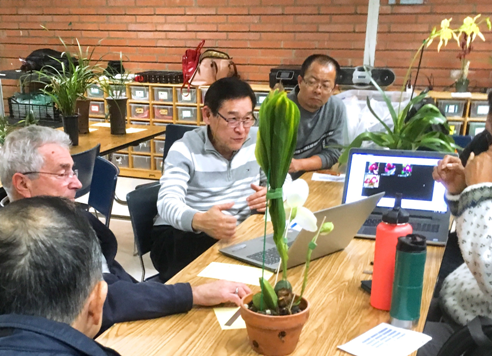
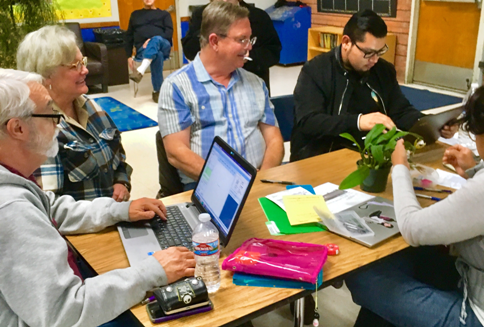
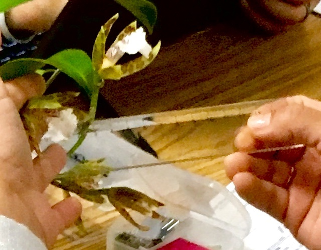
Copyright 2022 South Coast Orchid Society, Inc.